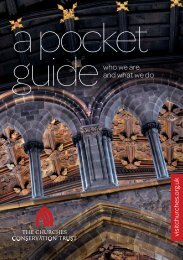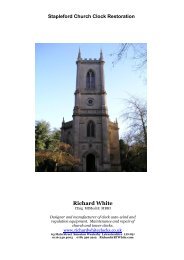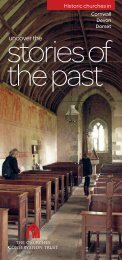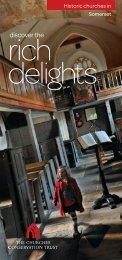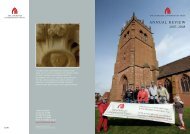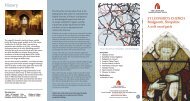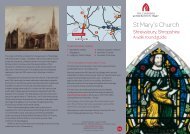All Souls Bolton Conservation Statement - The Churches ...
All Souls Bolton Conservation Statement - The Churches ...
All Souls Bolton Conservation Statement - The Churches ...
You also want an ePaper? Increase the reach of your titles
YUMPU automatically turns print PDFs into web optimized ePapers that Google loves.
2 UNDERSTANDING2.1. Historical background<strong>The</strong> town of <strong>Bolton</strong>-le-Moors (to use its full name) is a settlement in a naturalvalley on the West Pennine Moors on the banks of the River Croal, ten miles tothe north-west of Manchester. While close to that city and to Salford, the townhas its own distinct, and ancient, identity.<strong>The</strong> manor is first recorded in 1067, but the parish church of St Peter hasSaxon origins. <strong>The</strong> town was granted a Charter to hold an annual market byHenry III in 1251, and the Earl of Derby, William de Ferrers granted a Charterto make <strong>Bolton</strong> a market town and borough in 1253.Early industrial activity is evinced in the arrival of Flemish weavers in <strong>Bolton</strong>about 1337 to work in the textile industry, bringing other skills including clogmaking.<strong>Bolton</strong> was a centre of Puritanism, and during the Civil War was aParliamentarian outpost, surrounded by Royalist areas. <strong>The</strong> town was toremain a stronghold of Protestantism and non-conformity in a countyrenowned as a bastion of Catholicism, earning it the soubriquet ‘the Geneva ofthe North’.Until 1838 the area was divided between Little <strong>Bolton</strong> and Great <strong>Bolton</strong>, theboundary between the two being defined by the River Croal. In the same yearQueen Victoria granted <strong>Bolton</strong> Chartered Borough status. <strong>The</strong> jointpopulation at this time was about 47,000.<strong>The</strong>re was considerable distress in the town at this time, due to the high costof food brought about by the Corn Laws and other taxes, and unemploymentwas high. <strong>The</strong> Chartists rioted in the town in August 1839 and the ParishChurch was occupied, leading to considerable damage. In 1842 <strong>Bolton</strong> wasinvolved in the Plug Drawing Riots, when bands of rioters went around thetown pulling the plugs out of boilers, causing much damage to the reviled andthreatening factory machinery.It is unsurprising that <strong>Bolton</strong> should have witnessed such unrest andupheavals, for the town was at the forefront of the industrial revolution. It isthe birthplace of both Crompton and Arkwright, whose inventions in the lateeighteenth century had made possible the development of the cotton industryin these parts. In particular, Samuel Crompton’s Spinning Mule (1779)revolutionised the industry, and set the town on course to become a worldcentre of cotton spinning. By 1851 <strong>Bolton</strong> had some 65 cotton mills; by 1920there were about 120.It was in order to cater for the moral and spiritual welfare of those working inthe cotton mills in the expanding town that the mill owning brothersNathaniel and Thomas Greenhalgh built the church of <strong>All</strong> <strong>Souls</strong>. This was partof a major programme of church and chapel building in nineteenth century<strong>All</strong> <strong>Souls</strong>, <strong>Bolton</strong>: <strong>Statement</strong> of Significance 3





